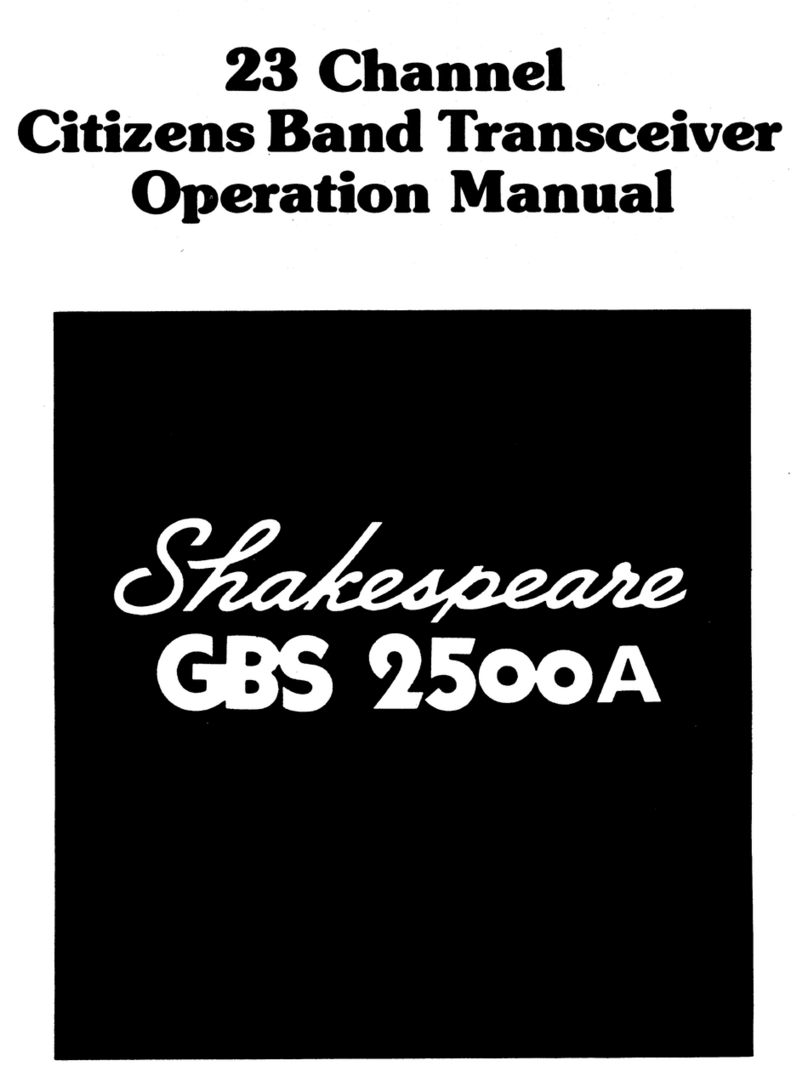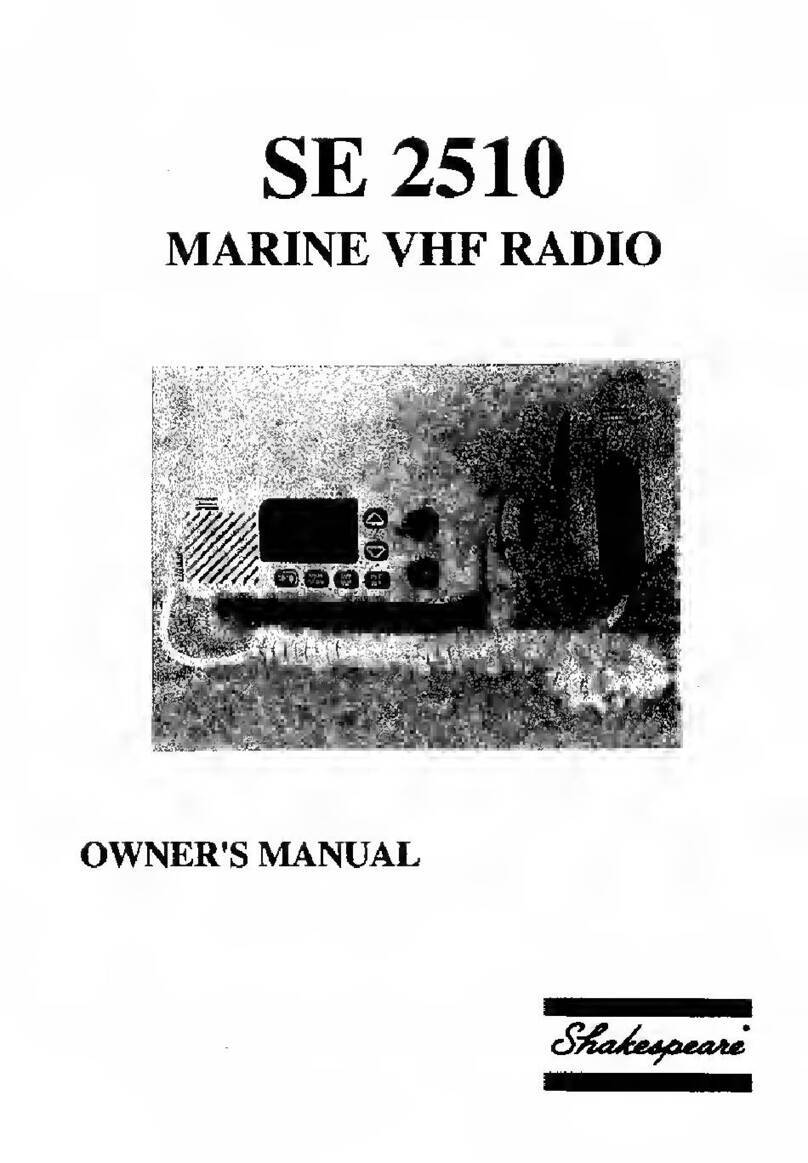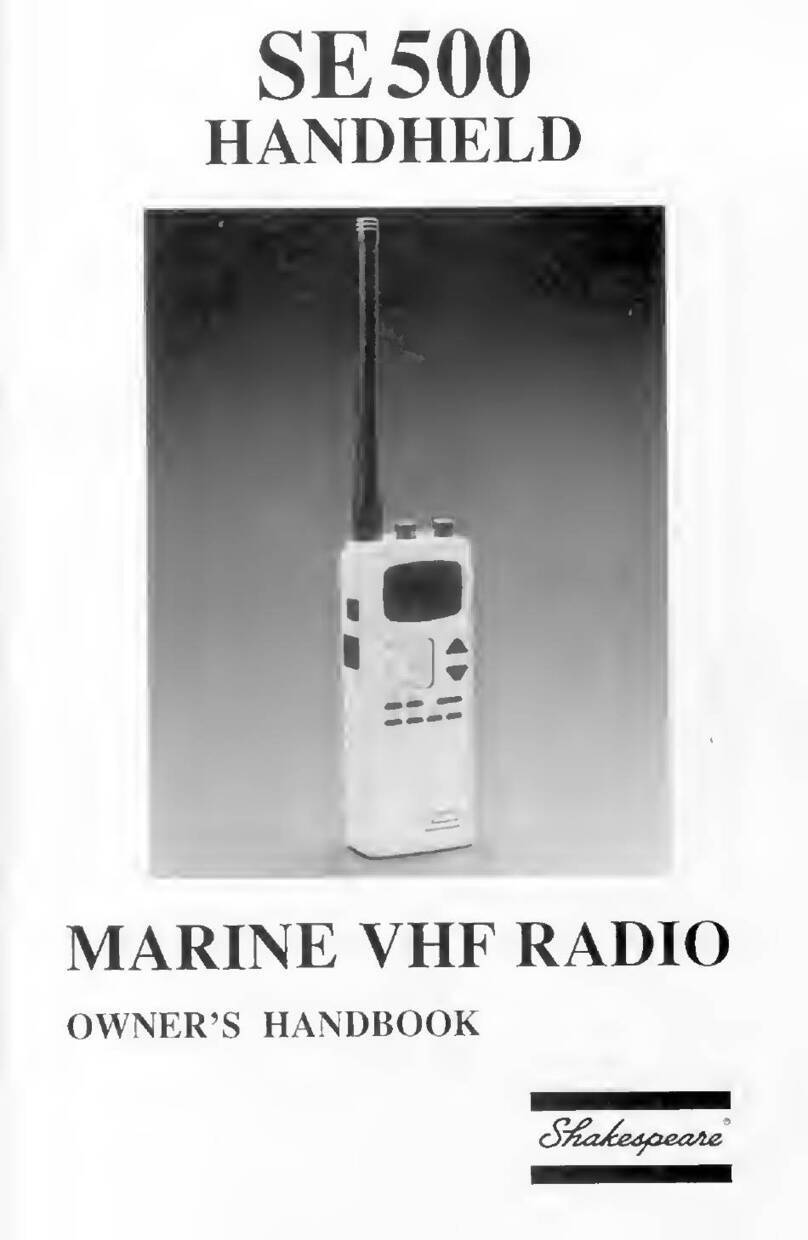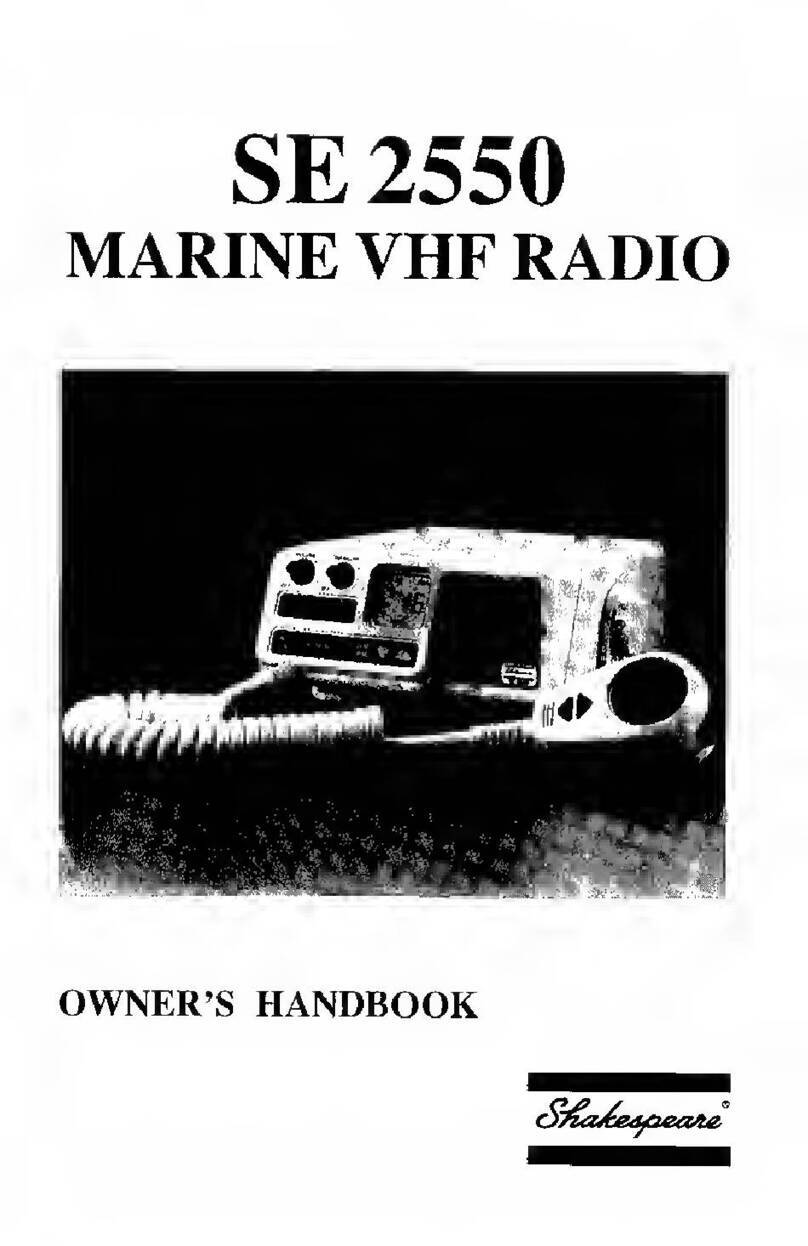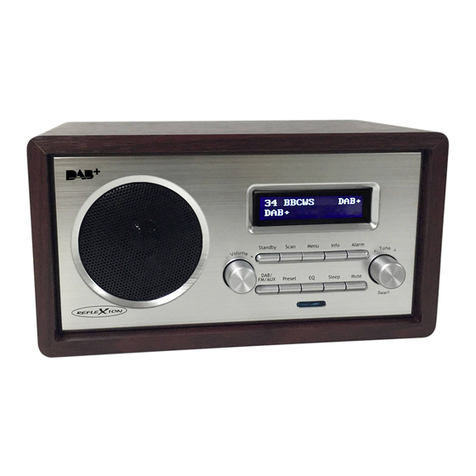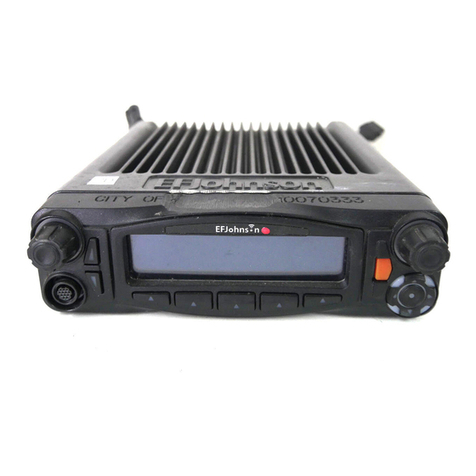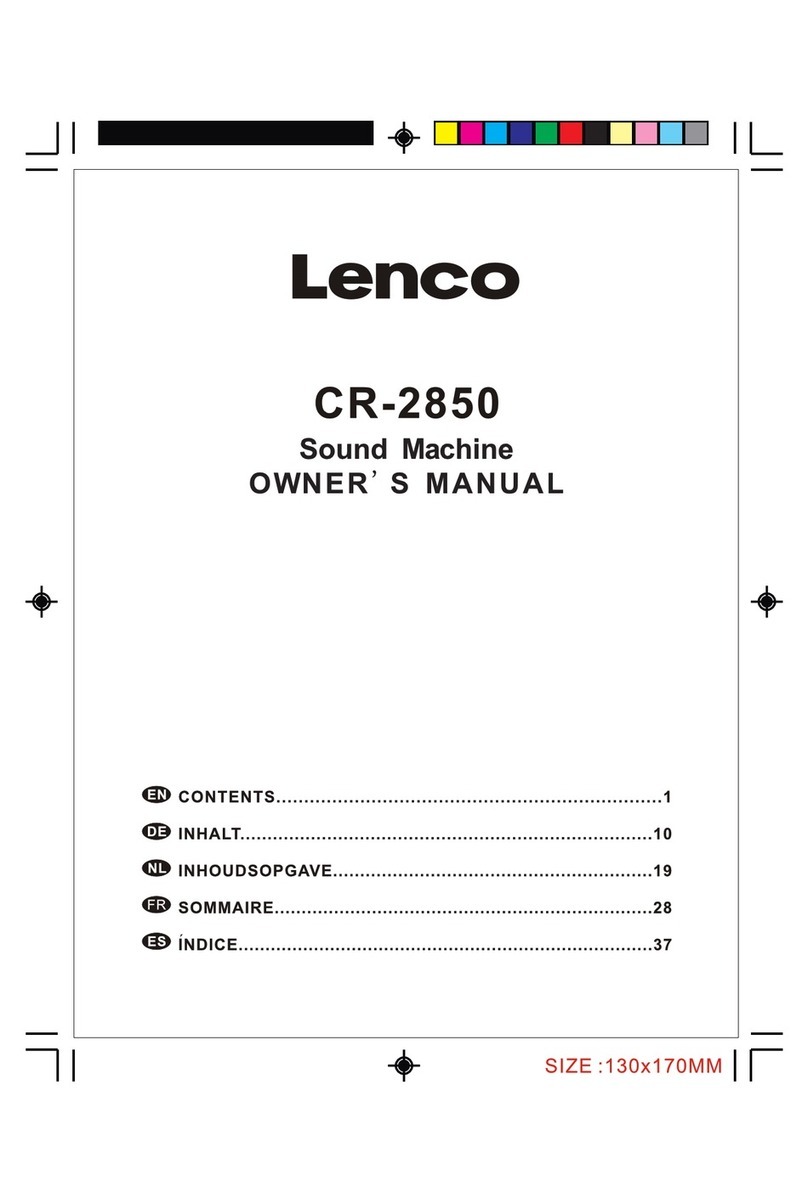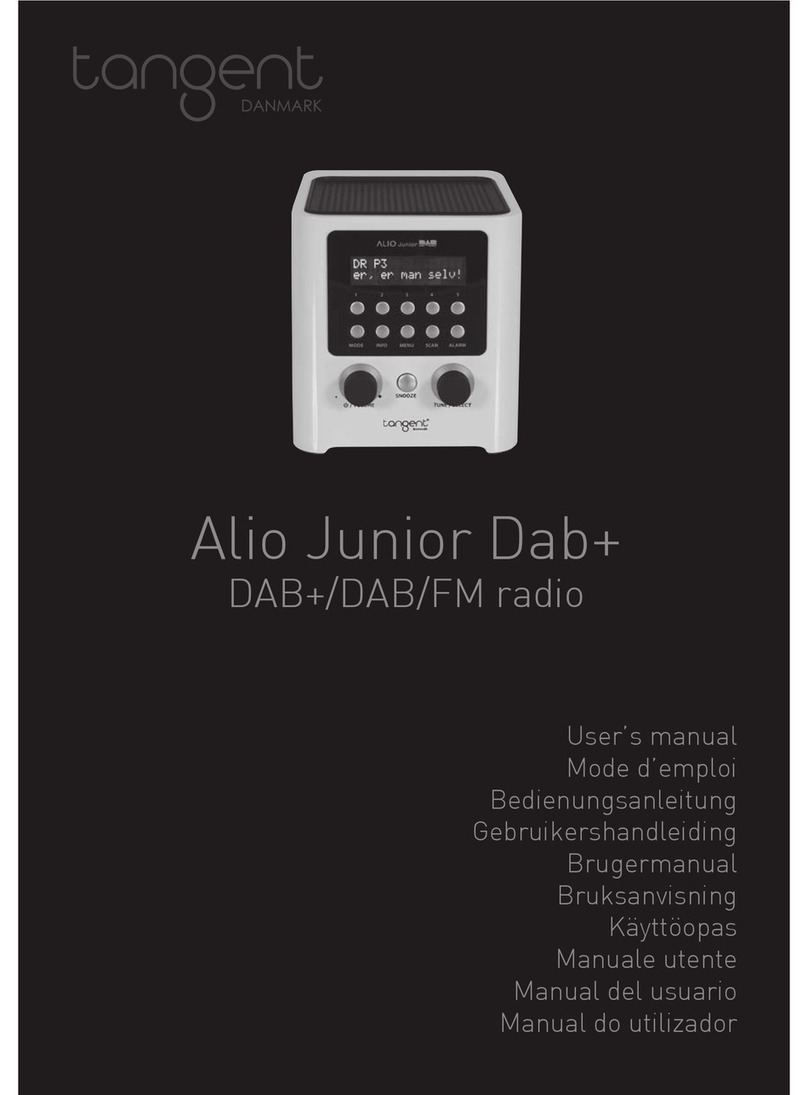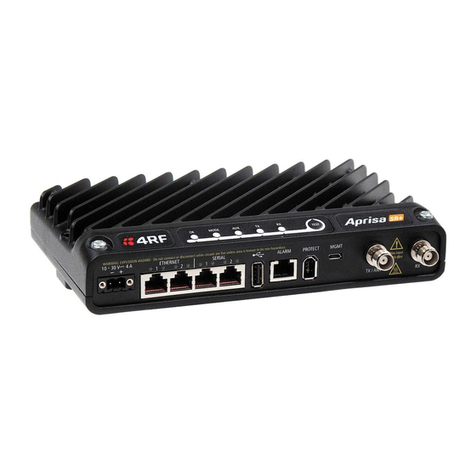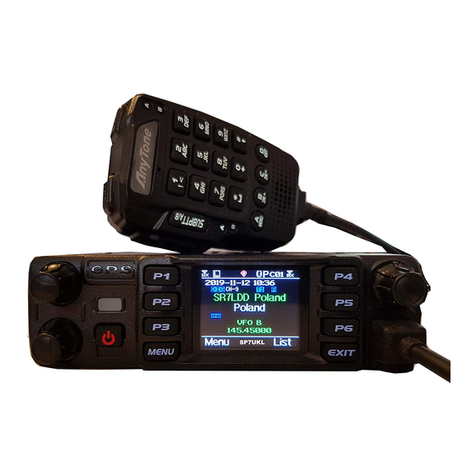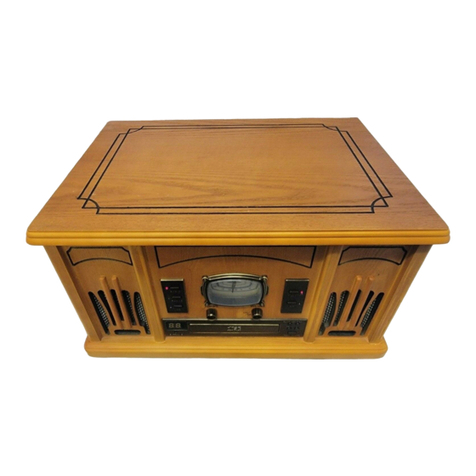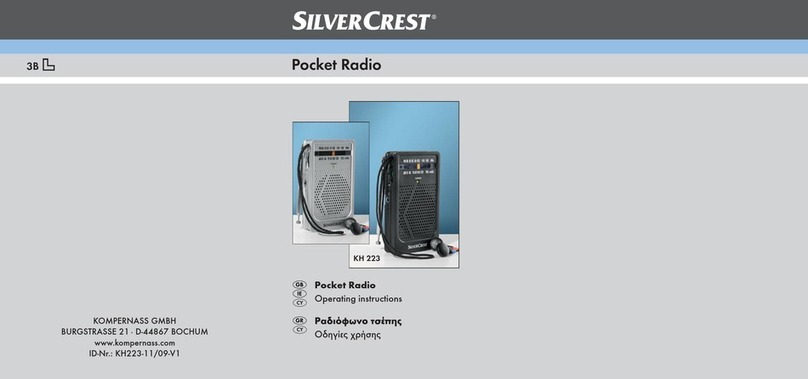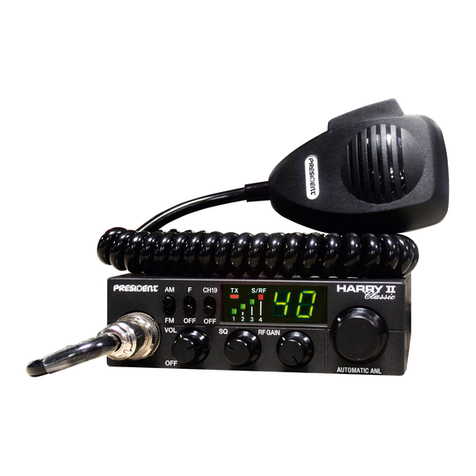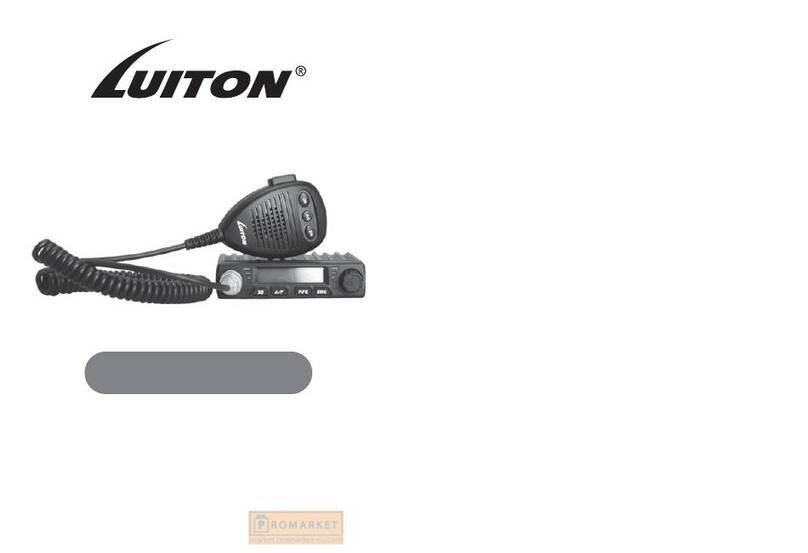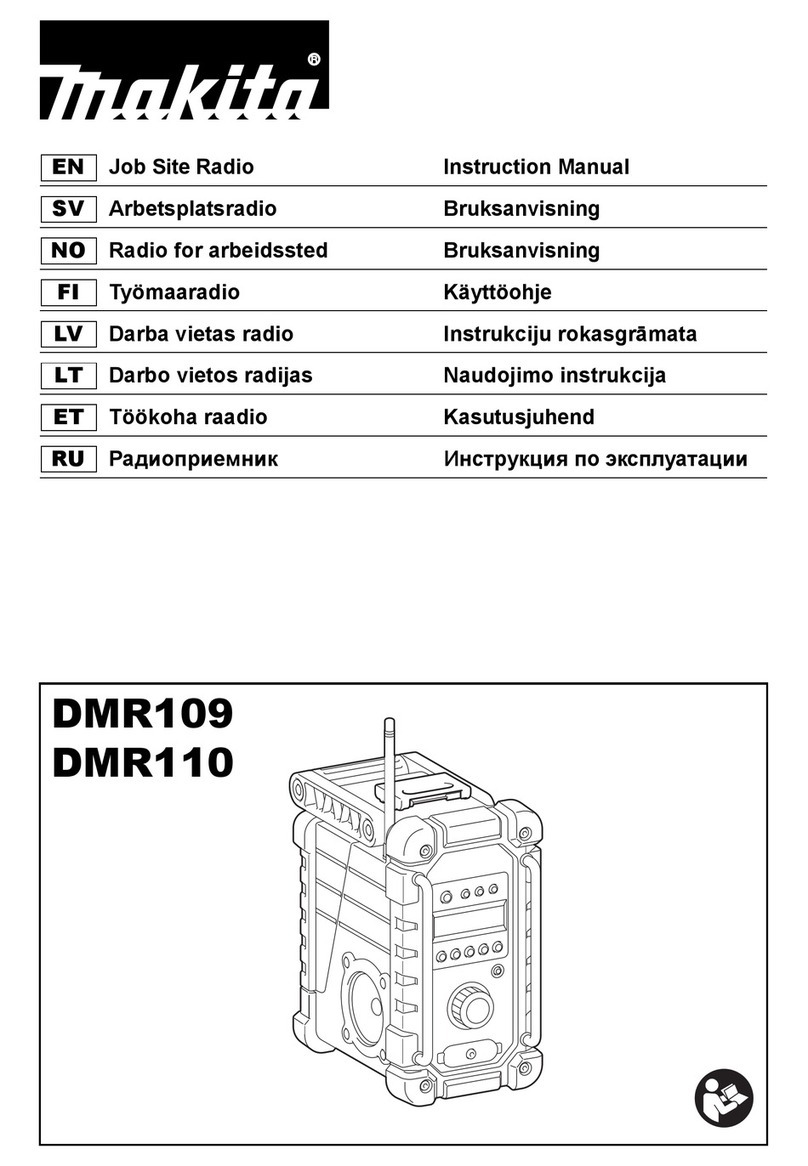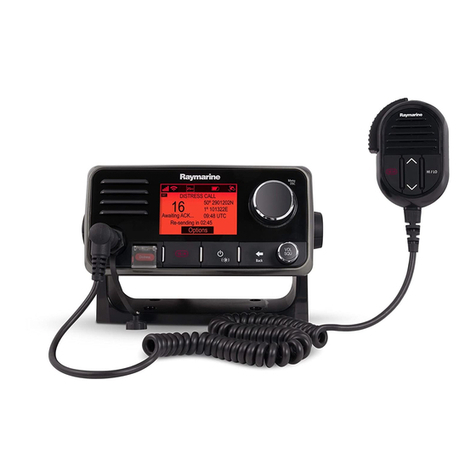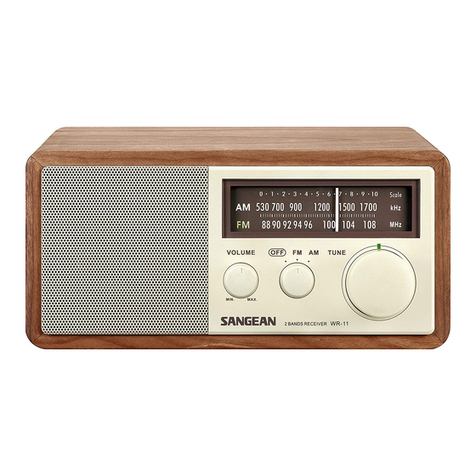Shakespeare Electronic SE 2500/S User guide

SE
2500/S
MARINE
VHP
RADIO

TABLE
OF
CONTENTS
1.0
Introduction.1
1.1
Purpose.1
1.2
Equipment
Description.2
1.3
Brief
Operating
Instructions.2
1.4
Technical
Specifications.4
1.5
Supplied
Parts
List.5
1.6
Optional
Accessories.5
1.7
License
Requirements.5
1.7.1
License
Application.6
1.7.2
Operator’s
License.6
2.0
Installation.
2.1
Unpacking
And
Inspection.7
2.2
Mounting
Preparation.7
2.3
Mounting
Location
Selection.7
2.4
Front
Panel
Reversal.8
2.5
Unit
Mechanical
Installation..
9
2.6
Electrical
Connectioas.9
2.6.
i
Power
Hookup.10
2.6.2
Antenna
Connection.10
2.6.3
Coax
Connector
Assembly....!
1
2.6.4
External
Speaker
Connection.12
3.0
Operation.
13
3.1
Controls
And
Display..13
3.2
Operating
Procedures.14
3.2.1
Power
and
Volume
Control.14
3.2.2
Display
Backlighting.14
3.2.3
Setting
Squelch.14
3.2.4
Channel
Selection.14
3.2.5
USA/lnfernational
Channel
Select.15
3.2.6
Voice
Transmitting.15
3.2.7
Hi^/Low
Transmit
Power....
16
3.2.8
Transmitter
3
Minute
Time
Out.16
3.2.9
Weather
Channels
Access.16
3.2.10
Channel
16
Priority.16
3.2.11
Chaiinen3/67
High
Power
Override
.17
3.2.12
Dual
Watch.
17
3.2.13
External
Speaker..17
3.3
Method.?
Of
Operation.17
4.0
Appendix.18
Appendix
A.IS
USA
VHF
Marine
Channel
Assignments
Appendix
B.19
VHF
Marine
Weather
Channel
Assignments
Appendix
C.
1
9
Itttcmational
VHF
Marine
Channel
Assignments
Appendix
D..20
Canadian
VHF
Marine
Channel
Assignments
Appendix
E.....22
Phonetic
Alphabet
And
Glossary
Appendix
F..23
Schematics

Figure
1-1
Shakespeare
SE
2500
Marine
VHF
Radio.
1.0
IMTRODUCnON
Welcome
and
congratulations
on
your
purchase
of
the
Shakespeare
SE
2500
Marine
VHF
radio.
You
have
purchased
a
high
technology
piece
of
marine
electronics,
fully
backed
by
the
Shakespeare
name.
The
Shakespeare
SE
2500
Marine
VHF
radio
incorporates
modern
styling
and
functionality,
making
the
Shakespeare
SE
2500
not
only
easy,
but
pleasing
to
operate.
The
frequency
synthesized
transceiver
provides
access
to
ALL
usable
U.S.
and
International
Channels.
Ten
weather
channels
are
also
available
through
easy
front
panel
key
presses
making
the
SE
2500
the
best
value
in
marine
VHF
radio.
The
key
to
obtaining
the
most
use
and
pleasure
from
your
new
VHF
radio,
is
reading
the
owner’s
manual.
This
manual
teaches
you
poper
transceiver
procedures
and
care
to
ensure
many
years
of
satisfying
use.
It
is
especially
important
to
cover
the
areas
of
this
manual
pertaining
to
"License
Requirements"
established
by
the
Federal
Com¬
munications
Commission.
1.1
Purpose
The
Shakespeare
SE
2500
Owner’s
Manual
is
designed
to
answer
your
questions
about
the
installation
and
operation
of
your
radio.
It
is
important
to
read
through
each
section
before
attempting
to
install
oroper^e
yourradio.
A
"Brief
Operating"
section
assures
you
are
on
the
air
quickly
and
properly.
Many
new
user
pitfalls
can
be
avoided
by
reading
this
manual.
1

1.2
Equipment
Description
The
Sliakespeare
SE
2500
Marine
VHP
radio
is
a
digitally
synthesized
transceiver
constructed
of
only
the
highest
grade
materials.
All
electronic
components
are
solid
state
providing
the
most
efficient
use
of
electrical
power.
The
Shakespeare
2500
VHP
radio
offers
two
output
settings,
1
watt
and
25
watts.
The
microprocessor
control
used
in
this
radio
offers
features
found
only
in
far
more
expensive
units.
Features
such
as
Dual
Channel
Watch.
Priority
Channel
16,
and
10
Weather
Channels
are
only
some
of
the
Shakespeare
SE
2500’s
many
extras.
1.3
Brief
Operating
Instructions
U.SC
the
following
brief
operation
instructions
to
quickly
refresh
your
memory
when
using
the
Shakespeare
SE
2500
Marine
VHP
radio.
Please
remember
that
this
section
is
not
designed
to
replace
a
thorough
study
of
the
Owner’s
Manual.
1-
Channel
16
select
key
2-
Power
and
Volume
control
3-
Squelch
Control
4-
Dual
Watch
active
indicator
5-
Weather
Channel
indicator
6-
Lo
Power
Output
indicator
7-
Transmit
active
indicator
8-
Hi
Output
power
indicator
9-
Intemational
channel
indcator
10-
USA
channel
indicator
11-
Active
channel
readout
12-
Speaker
13-
Dual
Watch
select
key
14-
Microphone
cable
15-
WeathCT
mode
select
key
16-
HI/LO
transmit
power
key
17-
USA/Internatioiial
channel
key
18-
Down
channel
select
key
19-
Up
channel
select
key
2

1.2
Equipment
Description
The
Shakespeare
SE
2500
Marine
VHP
radio
is
a
digitally
synthesized
transceiver
constructed
of
only
the
highest
grade
materials.
AH
electronic
components
are
solid
state
providing
the
most
efficient
use
of
electrical
power.
The
Shakespeare
2500
VHP
radio
offers
two
output
settings,
i
watt
and
25
watts.
The
microprocessor
control
used
in
this
radio
offers
features
found
only
in
far
more
expensive
units.
Features
such
as
Dual
Channel
Watch,
Priority
Channel
16,
and
10
Weather
Channels
are
only
some
of
the
Shakespeare
SE
2500’s
many
extras.
1.3
Brief
Operating
Instructions
Use
the
following
brief
operation
instractitxis
to
quickly
refresh
your
memory
when
using
the
Shakespeare
SE
2500
Marine
VHP
radio.
Please
remember
that
this
section
is
not
designed
to
replace
a
thorough
study
of
the
Owner’s
Manual.
1
2
3
4
5
6
7
J
J
10
11
12
13
14
15
16
17
18
19
1-
Channel
16
select
key
2-
Power
and
Volume
control
3-
Sque!ch
Control
4-
Dual
Watch
active
indicator
5-
Weather
Channel
indicator
6-
Lo
Power
Output
indicator
7-
Transmit
active
indicator
8-
Hi
Output
power
indicator
9-
Intemational
channel
indcator
10-
USA
channel
indicator
11-
ActLve
channel
readout
12-
Speaker
13-
Dual
Wateh
select
key
14-
Microphone
cable
15-
Weather
mode
select
key
16-
HI/LO
transmit
power
key
17-
USA/International
channel
key
IS-Down
channel
select
key
19-Up
channel
select
key
2

POWER
ON
VOLUME
SQUELCH
BACKLIGHT
USA/INT
SELECTING
CHANNELS
EMERGENCY
CALLING
TRANSMIT
POWER
TRANSMIT
WEATHER
CHANNELS
DUAL
WATCH
BRIEF
OPERATIONS
TABLE
Turn
Volume
Control
CLOCKWISE.
Adjust
Volume
Control
to
desired
setting.
Turn
Squelch
Control
knob
counterclockwise
until
noise
is
heard.
Turn
Squelch
Control
knob
clockwise
slowly,
Just
until
noise
is
no
longer
heard.
The
backlighting
is
on
all
the
lime.
This
key
changes
the
available
channels
to
USA
or
International
allocations.
See
Appendix
A
through
D
for
complete
channel
listing
and
usage.
Pressing
the
lUP/DOWl^
arrow
keys
on
the
front
panel,
or
the
front
of
the
microphone.scrolis
through
the
available
channels.
The
displayed
channel
is
the
active
channel.
Press
[I
3
key
for
channel
16.
This
channel
is
used
to
call
the
Coast
Guard
and
general
vessel
calling.
Always
switch
to
another
channel
to
chat.
To
leave
Emergency-Calling
Channel
16
press
|DW
WX|,
or
Channel
Select
lUP/DOW'N]
arrows
keys,
Press
iHI/LOl
to
toggle
between
1
and
25
watts.
Press
and
hold
die
PUSH-TO-TALK
key
on
the
top
of
the
microphone
to
transmit.
Press
1WX|
to
access
the
last
selected
weather
channel.
To
change
Weather
Qiannels
use
the
arrow
keys.
UP/DOWN
To
exit
the
weather
channels
press
|16|
or
|
WX
Set
Squelch,
then
select
a
channel
other
than
Channel
16.
Press
the
key.
To
stop,
press
|161
or
|
WX
|
.
NOTE
1
beep
confirms
a
valid
entry
or
selection.
3
beeps
mean
an
invalid
entry-PLEASE
TRY
AGAIN.
3

1.4
Technical
Specifications
General
Physical
Characteristics
Temperature
Range
Power
Requirements
Channels
Transmitter
Output
Power
Output
Impedance
Modulation
Frequency
Stability
Spurious
Emissions
Hum
and
Noise
Audio
response
Receiver
Sensitivity
Selectivity
Spurious
Response
Attenuation
Intermodulation
Spurious
Response
Attenuation
Audio
Output
Power
Audio
Distortion
Audio
Response
Squelch
Sensitivity
Height
2.5'
Width:
6.0"
E>epth:
8.0"
including
heat
sink
Weight
2.0
lbs.
-20
Deg
C
Id
+50
Deg
C
13.8
VDC
nominal,
5.5
A
transmit,
.2
A
receive
124
total,
57
USA,
57
International
and
10
Weather
25
Wall/I
Wan
50
Ohms
FM.
5
KHz
max
deviation
+/-.0005%{5ppm)
2.5uW(.56db)@
I
WattTx
25uW(.70db)
@25
WattTx
-40
db
Less
than
10%
distortion
at
3khz
deviation.
6db/octave
pre-emphasis.
Audio
low
pass
filter
included.
.25uV
or
less
for
12db
SINAD
.50uV
or
less
for
20db
SINAD
-6dbat7.5
KHz
-65dbat25KHz
70db
min.
70db
min.
3
Watts
@
8
Ohms
6
Walls
@
4
Ohms
External
10%
@
3
Watts
into
8
Ohms
+1/-3
db
matching
a
6db/octave
de-emphasis
from
300-3000HZ
Threshold:
.30
uV
Max,
Full
Squelch:
.80
uV
Specifications
are
subject
to
change
without
notice
and
are
nominal
unless
other¬
wise
indicated.
4

1.5
S
upplied
Parts
SE
2500
Radio
Transceiver
Plastic
Mike
Clip
with
screws
Special
Waterproof
Mike
Spare
7
Amp
fuse
Mounting
Knobs
Mounting
Bracket
Power
Cable
Assembly
with
fuse
holder
Owner’s
Manual
Waterproof
Brief
Instruction
Card
FCC
Applicalion-506
FCC
Restricted
Operator’s
Permit-753
Warranty
Card
1.6
Optional
Accessories
Flush
Mount
Installation
Kit
Reverse
Panel
Gasket
Be
sure
to
consult
your
marine
electronics
dealer
for
a
Shakespeare
antenna
that
best
suits
your
particular
installation.
Shakespeare
has
been
building
a
reputation
for
uncompromising
quality
in
marine
communications
for
more
than
35
years.
A
reputation
that
our
US
Navy
and
Coast
Guard
have
come
to
count
on.
So
whether
you
selected
your
Shakespeare
radio
for
peace
of
mind
or
for
fun,
we
recommend
you
consult
your
Shakespeare
marine
electronics
dealer
for
the
wide
variety
of
marine
antennas
and
accessories
available.
He
can
help
you
select
the
system
combination
that
best
fits
your
boat
and
needs.
1.7
License
Requirements
Pleasure
boats
(U.S.
vessels),
equipped
with
a
marine
radio,
must
have
a
Ship
Station
License.
Other
vessels
(including
compulsory
equipped
vessels)
may
require
a
Ship
Radio
Station
License
and
a
Commercial
Radio
Operator's
License
to
operate
the
radio
station.
If
the
ship
is
not
a
U.S.
vessel,
contact
the
local
authorities
to
determine
licensing
requirements.
When
purchasing
a
new
boat,
a
new
station
license
must
be
applied
for
as
the
"Ship
Station
License"
is
not
transferable.
Therefore,
upon
the
sale
of
your
boat,
the
FCC
requires
that
you
submit
your
old
license
for
cancellation.
5

A
change
in
mailing
address
requires
notification
to
be
filed
with
the
FCC.
This
notification
is
mailed
to;
.
Federal
Communications
Commissicm
P.
O.
Box
1040
Gettysburg,
PA
17326
1.7.1
License
Application
The
Ship
Radio
Station
License
is
obtained
by
filling
out
and
submitting
Form
506
with
$35
to
the
FCC.
DO
NOT
SEND
CASH.
To
(^rate
the
radio
while
waiting
for
the
license
to
be
returned
from
the
FCC,
fiU
out
and
keqj
the
bottom
part
of
Form
506.
This
"Temporary
Permit"
is
good
for
90
days
fixrm
the
date
the
Form
506
is
mailed
to
the
FCC.
Your
Ship
Station
License
is
valid
for
a
period
of
5
years.
The
call
sign
for
your
station
will
be
issued
on
the
license
and
the
temporary
permit
has
instructions
for
assigning
the
vessel’s
temporary
call
sign.
If
the
ship’s
radio
station
is
to
be
operated
in
other
countries,
contact
the
local
authorities
for
their
licensing
requirements.
Mail
Station
License
Application
form
to:
Federal
Communications
Commission
Marine
Ship
Service
P.
O.
Box
358275
Pittsburgh.
PA
15251-5275
1.7.2
Operator’s
License
A
Commercial
Radio
Operator’s
License
is
generally
not
required
to
operate
a
ship’s
radio
station
aboard
a
pleasure
boat.
A
Restricted
Radiotelephone
Operator
Permit
is
not
required
for
domestic
operation
of
a
marine
VHF
radio
for
U.S.
pleasure
boats
as
long
as
you
do
not
dock
in
any
foreign
ports,
ff
you
are
going
to
dock
in
a
foreign
port
or
plan
to
leave
a
foreign
port
to
dock
in
U.S.
ports,
it
will
be
necessary
to
obtain
the
Restricted
Permit.
To
do
this
fill
out
and
mail
to
ttie
FCG
a
Form
753
along
with
a
$35
fee
in
the
form
of
a
single
check
or
money
Older
payable
to
the
FCC.
DO
NOT
SEND
CASH.
For
further
license
informaticm
call
die
FCC
at
717-337-1212.
6

2.0
INSTALLATION
Before
using
the
Shakespeare
SE
2500
Marine
VHP
r^io,
please
study
the
following
section.
Failure
to
adhere
to
the
these
installation
and
operating
considerations
can
damage
or
significantly
degrade
the
perfoimance
of
your
VHP
radio.
2.1
Unpacking
And
Inspection
The
Shakespeare
SE
2500
Marine
VHP
radio
comes
to
you
100%
inspected.
When
unpacking,
check
the
parts
shipped
with
the
unit
against
the
supplied
parts
list.
If
there
is
a
discrepancy,
notify
your
selling
agent
or
Shakespeare
Customer
Service.
(1
-803-
276-5504)
If
the
radio
was
damaged
during
shipment,
save
ALL
packing
material
to
make
it
easier
to
file
a
claim
with
the
carrier.
All
damage
claims
from
shipment
must
be
filed
with
the
freight
carrier
used
to
ship
the
radio
to
you.
2.2
.Mounting
Preparation
Before
actually
mounting
your
new
SE
2500
Marine
VHP
radio,
take
a
little
time
to
read
over
the
installation
instructions.
You
will
find
there
are
many
things
to
take
into
consideration
before
drilling
that
first
hole.
Planning
every
aspect
of
the
installation
first,
will
save
time
and
aggravation.
It
will
also
save
money
by
cutting
down
potential
errors
that
require
repair
to
correct.
Before
mounting
begins
you
will
need
to
purchase
a
marine
VHP
radio
antenna.
Shakespeare
markets
a
full
line
of
high
quality
marine
VHP
radio
antennas
to
fit
every
installation.
The
dealer
you
purchased
this
radio
from
will
be
able
to
help
you
choose
the
antenna
style
best
suited
to
your
type
of
boating.
2.3
Mounting
Location
Selection
The
following
is
a
list
of
items
that
need
advanced
planning
before
selection
of
the
mounting
location.
1.
Find
where
the
vessel’s
+12
volt
supply
and
ground
are
located
and
what
it
will
take
to
get
the
radio
power
cable
assembly
to
it.
2.
Where
can
the
antenna
be
mounted
and
what
must
be
done
to
route
the
antenna
cable
to
the
radio?
NOTE
Keep
the
antenna
at
least
3
feet
away
from
the
radio
and
as
high
as
possible
for
best
performance.
7

3.
Where
is
the
best
place
to
mount
the
radio
itself?
Keep
in
mind
that
the
radio
may
be
table
top
mounted,
hang
mounted
overhead,
bulkhead
mounted
vertically,
under
counter
mounted
and
flush
mounted
using
the
optional
Flush
Mount
Kit.
4.
When
deciding
on
a
mounting
location,
visibility
of
the
front
panel,
access
to
the
front
panel
controls,
access
to
the
mounting
knobs,
room
for
rear
cable
connections
and
access
to
rear
cable
connections
must
be
addressed
and
planned.
Figure
2>1
Screws
to
remove
for
front
panel
reversal.
2.4
Front
Panel
Reversal
For
overhead
and
bulkhead
Installations
follow
these
instructions
to
reverse
the
front
panel.
Do
this
before
mounting
the
radio.
1.
Disconnect
all
connections
from
the
back
of
the
radio.
Then
remove
the
four
screws
on
the
back
of
the
unit
securing
the
case
to
the
chassis.
2.
Slide
the
case
off
of
the
radio
and
replace
the
original
front
panel
gasket
with
the
reverse
front
panel
gasket.
3.
Rotate
the
case
180
degrees.
4.
Tilt
the
display
forward
40
de^es.
5.
Slide
the
case
back
on
the
chassis.
Do
not
pinch
any
wiring
or
cabling.
6.
Seat
the
case
on
the
front
panel
and
re-install
the
screws
on
the
back
of
the
radio.
Do
not
over
torque
the
screws.
7.
Mount
the
trunnion
bracket
on
the
top
of
the
radio.
Figure
2-2
shows
the
"before"
and
"after"
results.
8

Figure
2-2.
Front
Panel
Reversal
procedure.
2.5
Unit
Mechanical
Installation
Once
a
mounting
location
has
been
chosen,
hold
the
mounting
bracket
at
the
place
where
the-unit
is
to
be
mounted.
Use
the
mounting
bracket
as
a
template
to
mark
the
places
to
drill
holes
for
the
mounting
screws.
To
mount
the
bracket
to
wood
use
stainless
steel
wood
screws.
If
the
unit
is
to
be
mounted
on
fiberglass,
use
stainless
steel
nuts
and
through
bolts
as
the
vibrations
found
on
most
pleasure
boats
will
loosen
self
tapping
screws
mounted
directly
into
fiberglass,
When
the
mounting
bracket
is
secured,
attach
the
SE
2300
to
the
bracket
using
the
mounting
knobs
supplied
with
the
unit.
For
overhead
and
bulkhead
installations
reverse
the
front
panel.
2.6
Electrical
Connections
The
back
panel
of
the
SE
2500
comes
with
die
following
standard
connections.
1.
Electrical
Power
(4-12
volts)
2.
Antenna
Connector
(for
PL-259
type
connections)
3.
External
speaker
(1/8
"
phono
plug
recqitacle)
9

EXTERNAL
SPEAKER
CONNECTOR
Figure
2-3
Rear
panel
electrical
connections.
2.6.1
Power
Hookup
The
SB
2500
is
supplied
with
a
power
cable
assembly.
The
free
end
of
the
cable
is
connected
to
the
battery
side
of
the
vessel’s
+12
volt
power
buss.
The
cable
is
equipped
with
a
7
Amp
in-line
fuse
holder
for
over-current
protection.
The
Red
(+)
side
is
connected
to
a
+12
volt
buss.
The
Black
(-)
side
of
the
cable
is
connected
to
the
Negative
or
Ground
side
of
the
ship’s
power.
After
the
power
cable
is
connected
to
the
ship's
power,
plug
the
connector
end
into
the
back
of
the
radio.
NOTE
Use
at
least
12
gauge
wire
to
carry
the
transmit
5.5
Amp
current.
This
wire
size
is
appropriate
for
up
to
20
feet
of
cable
length.
When
powering
up
the
SE
2500,
if
no
display
appears
once
the
power
is
turned
on,
check
the
power
cable
hookup
polarity
if
the
in-line
fuse
is
blown.
Remember
to
replace
the
fuse
with
one
of
the
same
7
Amp
rating.
Using
a
fuse
with
a
higher
rating
can
result
in
permanent
damage
to
the
radio.
2.6.2
Antenna
Connection
DO
NOT
attempt
to
operate
the
SE
2500
without
the
antenna
connected,
to
do
so
can
result
in
severe
damage
to
the
transmitter
portion
of
the
radio
and
void
the
warranty.
Plug
the
antenna
cable
PL-259
connector
into
the
antenna
connector
on
the
rear
panel
of
the
SE
2500
Marine
VHP
radio.
ALWAYS,
screw
down
the
outer
coupling
ring
of
the
connector
to
ensure
a
solid
connection.
10

STEP
1
STEP
6B
CTCQ
^
L
^
COUPLING
PL-259
RING
STEP
S
BRAID
Figure
2-4.
Coax
Connector
Assembly.
2.6.3
Coax
Connector
Assembly
1.
Trim
back
outerjacket
of
coax
back
1-1/8”.
2.
Trim
back
the
braided
shield,
13/16''
3.
Trim
back
center
insuiation
3/4"
4.
Siip
coupling
ring
over
cable.
5.
Insert
cable
through
the
middle
of
the
UG-175U
adapter.
6.
Fold
the
braided
shield
back
over
the
end
of
the
UG-
175U
adapter.
Be
sure
there
are
no
shield
wires
touching
the
center
conductor.
7.
Screw
the
UG-175U
adapter
into
the
PL-259
connector
while
feeding
the
end
of
the
center
conductor
of
the
cable
through
the
hole
at
the
end
of
the
plug.
8.
SolderthecenterconductorofthecoaxtolhecenterofthePL-259connector.
Trim
center
conductor.
Solder
braided
shield
to
the
PL-259
connector
via
the
small
holes.
9.
Screw
coupling
ring
onto
the
PL-259
cainector.
NOTE
If
you
are
not
sure
about
this
procedure,
have
a
qualified
marine
radio
service
technician
assist
you.
11

2.6.4
External
Speaker
Connection
In
high
noise
areas
it
is
often
desirable
to
install
a
more
powerful
external
speaker.
Purchasing
and
mounting
of
the
speaker
is
left
to
the
discretion
of
the
owner
as
there
is
a
great
variety
of
external
speakers
available,
but
be
sure
a
model
capable
of
8
Watts
is
purchased.
We
recommend
a
watertight
model
for
long
service.
Obtain
a
1/8"
phono
plug
from
your
local
electronics
supply
house.
To
connect
the
external
speaker,
solder
the
two
leads
from
the
speaker
to
the
connections
on
a
1/8"
phono
plug.
Next,
plug
the
phono
plugintotheextemalspeakerconnectoron
the
back
of
the
radio.
After
installation
is
complete,
use
the
external
speaker
as
you
would
the
internal
speaker.
12

Figure
3-1.
SE
2500
Front
Control
Panel.
3,0
OPERATION
The
Shakespeare
2500
Marine
VHF
radio
was
designed
for
the
tough
marine
environ¬
ment,
with
special
attention
paid
to
ease
of
operation.
TTie
following
section
helps
you
realize
the
maximum
benefit
of
your
purchase.
The
SE
2500
marine
VHF
radio
is
not
only
a
communications
convenience,
but
a
valuable
tool
in
life
threatening
situations.
This
life
saving
potential
makes
thorough
study
of
this
Owner’s
manual
extremely
important.
3.1
Controls
And
Display
All
controls
and
displayed
information
can
be
found
on
the
front
panel
oftheSE2500.
Two
knobs
on
the
front
panel
control
power
ON/speaker
volume
and
squelch
adjust¬
ment.
The
red
backlit
LCD
display
shows
selected
channel,
transmit
power
setting,
dual
watch
mode
and
transmit
mode.
The
tactile
keypad,
with
individual
switches
behind
the
overlay,
controls
selection
of
receive
and
transmit
channels,
transmit
power
level,
dual
channel
watch,
weather
channels,
USA
or
International
channels
and
instant
channel
16
priority
select.
A
singlebeepof
die
radio
indicates
a
valid
keyboard
entry.
Three
beeps
means
an
invalid
entry-
PLEASE
TRY
AGAIN,
IS

3.2
O
perating
Procedures
3.2.1
Power
and
Volume
Control
To
apply
power
to
the
SE
2500
VHP
radio,
turn
die
Volume
Control
knob
(front
left
control
knob),
clockwise.
A
“click”
is
heard
and
felt
At
this
point
the
display
shows
numbers
and
annunciators.
The
SE
2500
remembers
the
last
channel
and
mode
you
VOLUME
using
before
“TURN
OFF”
and
goes
to
this
same
con¬
figuration
at
"TURN
ON”.
The
next
thing
to
do
is
adjust
the
Squelch
(see
below).
To
do
this,
turn
the
Squelch
Control
knob
counterclockwise
until
static
is
heard
in
the
speaker.
Now,
the
volume
of
the
speaker
can
be
adjusted
to
a
reasonable
level
by
the
Volume
Control.
Make
this
adjustment
by
turning
the
volume
control
back
and
forth
until
you
are
comfortable
with
the
background
Noise
level.
3.2.2
Display
Backlighting
The
backlighting
of
the
display
comes
on
when
the
SE
2500
is
powered
up
and
stays
on
for
the
entire
time
period
that
the
radio
is
on.
There
is
no
brightness
adjustment,
3.2.3
Setting
Squelch
To
adjust
the
squelch
setting,
start
by
turning
the
Squelch
Control
knob
(front
right
control
knob),
all
Che
way
counterclockwise.
Rotate
the
Volume
Control
knob
until
the
static
noise
heard
in
the
radio
speaker
is
at
a
comfortable
level.
Next,
when
no
radio
transmissions
are
being
heard,
turn
the
Squelch
control
knob
clockwise
just
to
the
point
that
the
static
noise
is
no
longer
heard.
This
quiets
the
static
between
received
radio
transmissions
and
still
allows
the
incoming
mes¬
sages
to
be
heard.
The
level
of
squelch
adjustment
needed
to
quiet
the
radio
static
noise
is
dependent
on
the
background
static
intensity.
Keep
in
mind
that
the
squelch
may
need
to
be
adjusted
when
listening
to
a
different
channel.
SQUELCH
3.2.4
C
hannel
Selection
CHANNEL
SELECT
KEYS
Channel
selection
for
the
normal
trans¬
mit/receive
channels
is
handled
by
two
separate
sets
of
controls.
One
set
of
channel
A.
USA
INT
3
selection
arrow
keys
is
found
on
the
front
panel
directly
below
the
LCD
readout.
The
14

other
set
is
found
cm
the
front
of
the
microphone.
The
current
channel
selection
is
viewed
in
the
LCD
dis¬
play
area.
Tochange
channels
using
either
set
of
arrows,
simply
press
lUP/DOWNI
arrow
keys.
Observe
the
chang¬
ing
channels
in
die
LCD
display
area.
From
your
present
channei,
pressing
lUPl
arrow
key
will
in¬
crease
the
channel
numbers.
In
the
same
respect,
from
your
present
channel,
pressing
the
IDOWNI
arrow
key
decreases
the
channel
numbers.
If
the
highest
or
lowest
channel
available
is
reached
and
the
pressing
of
the
arrow
key
is
continued,
the
channel
numbers
will
cycle
around
to
the
top
or
bottom
of
the
list
and
continue
changing.
Holding
the
[UPI
or
[DOWN]
changes
the
channel
at
a
rapid
rate.
Practice
several
times
to
become
accustomed
to
this.
Some
channels
have
no
TX
function
(ie.
15,75,76
guard
channels).
Please
study
die
channel
allocation
list
in
the
Appendix
to
become
familiar
with
the
proper
and
customary
usage.
3.2.5
USA/International
Channel
Select
The
SE
2500
i.s
programmed
to
access
both
United
States
and
International
channels.
Which
set
of
channels
you
use
is
determined
by
the
area
of
operation.
Nornially
in
U.S.
coastal
areas
and
ports,
the
USA
channels
ate
selected.
To
toggle
betw
een
USA
and
International
channels,
press
the
lUSA/IP?T]
key.
The
channel
type
selected
is
indicated
in
the
display.
CHANNELTYPE
PUSH
TO
TALK
3.2.6
Voice
Transmitting
Until
you
have
memorized
the
proper
usage
of
each
channel,
refer
to
the
Assignment
Appendices
before
attempting
to
make
a
voice
transmission.
There
you
will
find
a
listing
of
the
channels
and
their
usage.
Once
the
proper
channel
has
been
selected,
locate
the
Push-To-Talk
key
on
the
top
of
the
microphone.
The
Push-To-Talk
k
ey
will
be
referred
to
from
here
on
out
as
the
IPTTI
key.
To
transmit,
press
and
hold
[piTl
for
the
entire
transmission.
While
iPTTI
is
held
in,
speak
i
nto
the
microphone
slo
wly
and
clearly,
When
the
transmission
is
complete,
release
the
|PTT|
key.
While
the
|PTT|
key
is
being
held,
"TX"
appears
in
the
LCD
display
window.
15

3.2.7
High/Low
Transmit
Power
The
SE
2500
has
two
transmit
power
output
levels,
1
Watt
and
25
Watts.
The
low
power
level
(1
Watt)
is
provided
for
situations
where
the
two
parties
involved
are
close
to
each
other.
This
reduces
the
congestion
on
the
same
channel
in
areas
far
away,
allowing
more
individuals
to
use
a
channel
at
one
given
time.
To
toggle
the
power
output
selection
between
"LO"
and
"HI"
press
the
[HJ
The
transmit
power
output
level
is
displayed
in
the
LCD
display
window.
3.2.8
Transmitter
5
Minute
Time
Out
In
the
event
that
the
|PTT
key
is
held
in
for
too
long,
the
transmitter
timer
will
disengage
the
transmit
function
afterS
minutes.
The
|
PTT
|
must
be
lifted
and
pressed
again
to
continue
transmission.
This
is
designed
»
prevent
a
channel
from
acciden¬
tally
being
tied
up
by
a
malfunctioning
micrc^hone
or
transmitter.
3.2.9
Weather
Channels
Access
The
SE
2500
has
the
ability
to
monitor
National
and
International
weather
service
broadcast.
This
safety
feature
allows
you
to
listen
to
weather
reports
at
any
time
so
changes
can
be
made
in
your
boating
plans.
This
allows
you
to
alter
your
planned
course
and
to
make
shipboard
preparations.
To
change
from
standard
marine
VHP
chan-
nelsto
the
weather
channel
broadcast,
press
the
IwTI
key.
"WX"
appears
in
the
LCD
display
indicating
weather
channel
reception.
The
in¬
itial
weather
channel
displayed,
is
the
last
one
used.
Use
the
channel
change
arrow
keys
on
the
microphone
or
the
front
panel
to
select
a
another
weather
channel.
To
cancel
weather
channel
access,
press
the
|
WX|
or
the
1161
key.
3.2.10
Channel
16
Priority
CH
16
PRIORITY
KEY
As
a
convenience
and
safety
feature,
the
SE
2500
marine
VHP
radio
has
a
channel
|16|
priority
key.
Pressing
this
key
from
any
mode
or
channel
immedi¬
ately
changes
the
selected
channel
to
channel
16
with
the
power
output
changed
to
To
leave
Emergency-Calling
Channel
16,
press
the
channel
selection
keys.
16

3.2.11
C
hannel
13/67
High
Power
Override
Due
to
the
special
usage,
FCC
assigned
channels
13
and
67
are
restricted
to
1
Watt
under
normal
conditions.
In
some
simations
it
is
acceptable
to
override
this
output
level
and
transmit
on
channels
13
and
67
at
25
Watts.
To
do
this,
press
and
hold
the
1
HI/LOl
key
on
the
front
panel
of
the
radio
for
the
duration
of
the
transmission.
The
LCD
display
shows
"HI"
in
the
display
window
while
the
I
HI/LOl
key
is
held
in.
Upon
releasing
the
Hl/LO
key,
transmit
output
power
is
dropped
back
to
1
Watt.
When
another
marine
VHF
channel
is
selected,
the
IHl/LO
|
key
toggles
the
transmit
power
setting
between
1
and
25
watts,
and
does
ntH
have
to
be
held
in
for
"HI"
power.
3.2.12
Dual
Watch
The
Dual
Watch
feature
allows
you
to
monitor
channel
16
and
ONE
other
channel.
To
make
use
of
this
feature
the
squelch
must
be
proper¬
ly
set,
Once
the
squelch
is
set,
select
the
"oihcr"
channel
using
the
chan
nel
se
lect
arrow
keys
on
the
front
panel
or
front
of
the
microphone.
Next,
press
the
|DW|
key.
"DW"
is
annunciated
in
the
LCD
display.
The
channel
display
then
changes
between
channel
16
and
the
"other"
channel
until
a
squelch
break
occurs.
The
channel
displayed
at
the
time
of
the
squelch
break
is
then
held
in
the
display
for
4
seconds
after
the
end
of
the
squelch
break.
Pushing
the
IPTTI
key
disables
the
Dual
Watch
mode
a
t
any
t
ime.
Also,
p
ressin
g
the
channel
arrow
keys,
the
channel
[I^
priority
key,
the
IWX
I
key
or
the
|DW|
key
turns
the
Dual
Watch
mode
OFF.
Any
other
key
press
produces
3
beeps
and
results
in
no
change
in
current
configuration.
3.2.13
External
Speaker
When
the
external
speaker
is
connected
to
the
SE
2500,
the
speaker
on
the
front
panel
is
disabled
automatically.
The
volume
is
adjusted
in
the
same
way
as
it
is
for
the
front
panel
speaker
using
the
volume
control
knob.
3.3
Methods
of
Operation
The
marine
VHF
radio
channels
are
becoming
ever
increasingly
crowded.
This
makes
it
very
important
and
every
users
lesponsibili^
to
help
relieve
channel
congestion
through
use
of
professional
radio
techniques.
The
following
the
suggested
rules
will
help
everyone
using
marine
VHF.
17
Other manuals for SE 2500/S
1
Table of contents
Other Shakespeare Electronic Radio manuals
